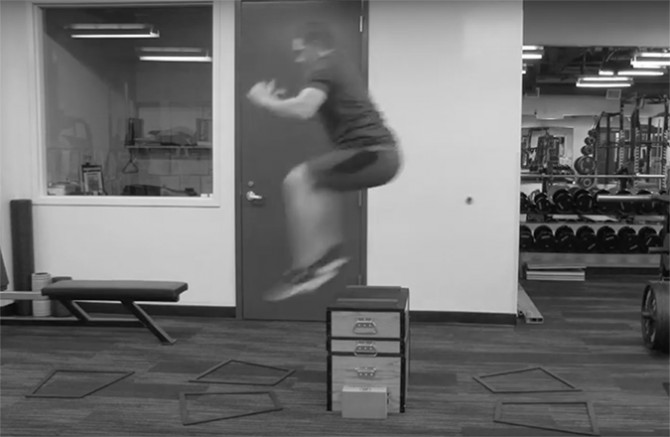
The box jump is one of the best exercises for improving vertical jump and building explosive power that’s applicable to just about every sport from skiing and snowboarding, to surfing and climbing and even mountain biking. But very few people are getting the most from this potent move, and some are even doing it in a dangerous way that increases their injury risk. Here are 5 ways to boost your box jump:
Mix It Up
It’s not only dull to keep doing the same old moves every time you hit the gym, but also causes your body to stop adapting. As head strength and conditioning coach for the Los Angeles Lakers, Tim DeFranceso helps a lot of freaky athletes develop even more impressive leaping ability by adding new elements to fundamental movements. To help his clients improve their jumping in more game-like scenarios, he has created several box jump variations that include the kind of lateral movement that often precede and follow a vertical jump in basketball. These are applicable to just about any sport in which you’re moving explosively from side to side as well as forward and backward. Our favorite is the drop step one shown in this video, but you can experiment by adding your own three-dimensional footwork movements in before and after the box jump.
Involve Your Upper Body
Too many people remain fixated on body part training, not realizing that the brain learns through movements, not muscles. As a result, they do a couple of “leg days” each way, and pair box jumps with squats, lunges or other so-called “lower body exercises.” This means that from the beginning, they’re considering jumping to be a legs-dominated movement. Not so. Look at the arm swing that pro dunk specialist Jordan Kilganon employed in this unreal reverse dunk (below) at this year’s NBA All Star Weekend (in hipster jeans, no less). The same is true of all great leapers: they involve their upper body. To make sure you’re not leaving untapped power on the table, pull your arms behind you and turn your palms to the ceiling to generate external rotation torque in the shoulders right before you leap. Then, as you explode from the ankles, knees and hips, aggressively throw yourself into the air with your arms. Just doing this could add a couple of inches to your vertical (even if you won’t be challenging Kilganon anytime soon).
Ditch the Duck Feet (or Pigeon Toes)
Are you a duck or a pigeon? No? Then why are you walking, running and jumping with your feet turned out or in? The body will put up with a lot of nonsense when it comes to suboptimal foot positioning during everyday life, even though ducking or pigeoning your toes will mess up your seated and standing posture and can contribute to ankle, knee, hip and lower back issues. But as soon as you get explosive, the negative impacts can be dramatically worse. In his book Chasing Perfection, Andy Glockner quotes Dr. Michael Clark (founder of Fusionetics and a key contributor to the Phoenix Suns’ brilliant medical team) as saying that “every ten degrees of inward bend of a knee when jumping or running puts 50 percent more torque on a player’s anterior cruciate ligament.”So unless ACL repair surgery sounds like fun, make sure you land with your feet straight (neutral) each time you hop up on the plyo box. Also land on the balls of your feet and create hip stability by screwing your feet into the box and shoving your knees out.

Respect Your Central Nervous System
Box jumps don’t just exact a high physical toll – they also tax the Central Nervous System (CNS). While other bodily systems are quick to recover from a stimulus, the CNS requires 48 to 72 hours to fully recover from Olympic lifts, sprinting and yes, you guessed it, plyometrics like box jumps. So in this case more is definitely NOT better, and you shouldn’t be trying to box jump every day to try and reach Zach Levine-like leaping levels (or whatever the equivalent would be in your rec league). Make sure you limit box jumps and similar exercises to two or, at a push, three sessions a week.
Stop Jumping Down!
There are certain exercise programs that encourage participants to complete a high number of box jumps in as little time as possible. While trying to decrease the amount of time you spend on the floor can increase explosiveness, box jumps interspersed with a non-ballistic step down will do the job. All plyometric jumping exercises are high impact, placing a large amount of stress on the muscles, ligaments and tendons. If you have any tightness at all in your heel cord and the surrounding tissues, you might get away with a session or two of jumping up and down 30, 40 or 50 times. But eventually your Achilles tendons will say enough is enough, and even elite athletes like the recently retired Kobe Bryant know all too well, the results ain’t pretty. So do yourself a favor and start carefully stepping back to the ground after each rep.

